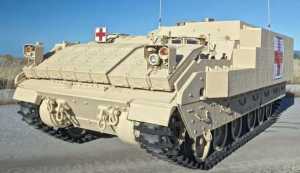| Designation: | Bradley AMEV |
 |
|---|---|---|
| Manufacturer: | BAE Systems Land and Armament | |
| Product type: | Armoured Vehicles | |
| Name: | Ambulance vehicle |
The Bradley Armored Medical Evacuation Vehicle (AMEV) is a Bradley A3 based variant which operates in the forward area with armored and mechanized battalions. The AMEV delivers life-saving combat medical support under the Bradley A3 protection level to the casualties, evacuees and combat medics.
The AMEV provides increased interior space for all the equipment and supplies required to perform the medic’s duties while providing the proven survivability and force protection of the Bradley A3 vehicle. The AMEV supports all standard and advanced medical components and kits available in the military supply systems.
The AMEV’s ability to rapidly collect, evacuate, and perform life-saving enroute treatment is critical to sustaining the force. The AMEV is completely self-contained with interior workspace and medical equipment, NBC protection for crew and patients, and has electrical lifting mechanism that assists the crew with loading patients in the top litter racks. The AMEV brings the level of care expected in modern civilian trauma ambulance vehicles to the HBCT formation.
- Armored Medical Evacuation Vehicle (AMEV)
- Armored Medical Treatment Vehicle (AMTV)
- Bradley Command Post (BCP)
- Bradley Mortar Vehicle (BMV)
- Bradley General Purpose Vehicle (BGPV)
BFoV platforms possess exceptional survivability against kinetic energy and artillery munitions.With the common Bradley reactive armor installed, the BFoV will provide the same level ofhand-held High-Explosive Anti-Tank (HEAT) and Anti-Tank Guided Missile (ATGM) protection asthe BFV. BFoV platform design incorporates all of the Bradley Urban Survivability Kits (BUSK)that have been developed in response to the changing threat environment.
The BFoV variants are as mobile and agile as the platforms currently residing in the HBCT formation. This increased mobility over the M113 FoV provides the maneuver commander the freedom to execute operations without being hindered by the inability of his critical battlefield functions to keep up with the rest of the force.
BFoV replacements for the M113 FoV establishes 74% commonality across the HBCT formation thus reducing the HBCT logistics tail, simplifies crew and maintenance training and enables more efficient sustainment and capability upgrades.
The increase in available space provides the ability to integrate more capable MEPs for each mission role.
- basic airway
- oxygen suction
- bleed control
- vital signs monitor
- splints
- extrication gear
- advanced airway
- ventilation
- fluid change
- medication
|
||||||||||||||||||||||||||||||||||
